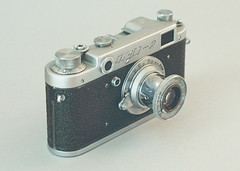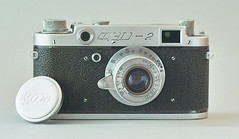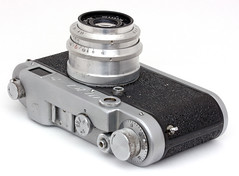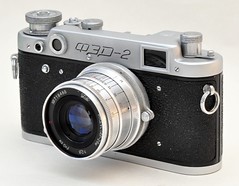Difference between revisions of "FED 2"
| Line 50: | Line 50: | ||
=== Shutter === | === Shutter === | ||
The Fed 2 has a curtain shutter with speeds from B, 1/25-1/500s. After detaching the back, two screws on the underside of the camera allow you to adjust the spring tension and change the shutter speeds, which may have become slow over time. | The Fed 2 has a curtain shutter with speeds from B, 1/25-1/500s. After detaching the back, two screws on the underside of the camera allow you to adjust the spring tension and change the shutter speeds, which may have become slow over time. | ||
| − | As with almost all Russian focal-plane shutter cameras, whether Leica-based or [[Kiev|Contax-based]], it's important to cock the shutter ''before'' operating the shutter speed dial. Failing to do so may harm the mechanism. When firing, this dial will rotate. After recocking, the speed set will be indicated correctly again. | + | As with almost all Russian focal-plane shutter cameras, whether Leica-based or [[Kiev|Contax-based]], it's important to cock the shutter ''before'' operating the shutter speed dial. Failing to do so may harm the mechanism, and in the best case scenario will cause the shutter to malfunction for many exposures afterwards. When firing, this dial will rotate. After recocking, the speed set will be indicated correctly again. |
=== Lens === | === Lens === | ||
The FED 2 takes 39mm screw lenses. The [[rangefinder (device)|rangefinder]] is coupled to the lens via a cam at the top of the lens mount, shaped somewhat differently than the cam in a Leica. The field of view in the viewfinder is that of a 5cm lens. For other focal lengths, a separate turret or fixed viewfinder was placed on the accessory shoe. | The FED 2 takes 39mm screw lenses. The [[rangefinder (device)|rangefinder]] is coupled to the lens via a cam at the top of the lens mount, shaped somewhat differently than the cam in a Leica. The field of view in the viewfinder is that of a 5cm lens. For other focal lengths, a separate turret or fixed viewfinder was placed on the accessory shoe. | ||
| − | The early models were factory-matched to a 5c lens, normally the Industar 26m. Examples sold online to the West in recent years sometimes come with the Industar 22, a Tessar copy in a collapsible tube mount copied from the Leitz | + | The early models were factory-matched to a 5c lens, normally the Industar 26m f:3.5 with a focal length usually slightly more than 50mm, depending on the year. Examples sold online to the West in recent years sometimes come with the Industar 22, a Tessar copy in a collapsible tube mount copied from the Leitz Elmar, itself a modified Tessar design with the diaphragm in a different position. The lenses are calibrated to the camera, and the manual indicates that other lenses should be calibrated before use as well, though it seems likely that this was rarely done in practice. |
| − | There is significant debate about whether these lenses can be mounted on other M39 cameras and focus accurately, and vice versa. A small majority of experts seem to believe that, while there may be errors, especially if the rangefinder has not been recently adjusted, these errors are negligible, especially at small aperture. | + | There is significant debate about whether these lenses can be mounted on other M39 cameras and focus accurately, and vice versa. A small majority of experts seem to believe that, while there may be errors, especially if the rangefinder has not been recently adjusted, these errors are negligible, especially at small aperture. In fact, it seems that most examples of this camera will have little trouble mounting Leica, Canon and other fine M39 lenses, and may be one of the cheapest cameras capable of so doing. |
| + | |||
| + | == Conclusion == | ||
| + | |||
| + | While hardly comparable to the early Leicas in terms of fit-and-finish, reliability and accuracy, there is something to be said for this camera: in some ways it does represent a upgrade from the early Leica II's: the convenience of a combined rangefinder/viewfinder cannot be understated, and a back-loading camera is a massive convenience compared to the bottom-loading Leica design. | ||
| + | |||
| + | Furthermore, the FED has never cost even in the vicinity of a Leica, and it is possible to buy functional examples online for the same amount one might pay for a K-mount Pentax SLR, or less. In fact, an economic route to professional image quality on film might be to purchase a FED, calibrate it well and find a used Leitz Elmar or other lauded 50mm (which will cost more than the camera did) and shoot with the resulting kit. | ||
== Images == | == Images == | ||
Revision as of 16:14, 13 June 2019
| FED 2 | ||
|---|---|---|
Manufacturer: FED Date of Production: 1955-1970 Type of Camera: Rangefinder Film Type: 35mm Lens: 39mm Screw Mount Shutter: Focal plane, cloth curtain Shutter range: 1/25-1/500th + Bulb Size (w*h*d): 140mm * 80mm * 32mm |
The FED 2 is a Leica-screw-mount rangefinder camera made at the FED factory in the Soviet Union. It is a new design that is quite different from the FED 1 in terms of its rangefinder/viewfinder setup: it has a longer rangefinder base (67mm), a combined viewfinder and rangefinder window and an adjustable diopter for the viewing window. It also has a self-timer in later iterations, and a detachable back for film-loading, unlike the FED 1 and the Leicas it was copied from. The camera is still recognizable as a variation on the Barnack-designed screwmount Leicas, while its successors would not be.
Variations
There are six variations recognized by most collectors.
- FED 2a was introduced in 1955.
- FED 2b has flash sync added. The new shutter speed dial has the reference point on a center post that rotates with the dial as the shutter is fired.
- FED 2c has the flash sync port moved to the top deck from the body. It also has a mushroom-shaped film advance knob.
- FED 2d has a new set of shutter speeds, from 1/30 to 1/500, instead of the older set of 1/25 to 1/500.
- FED 2L is the only factory-designated model number; all other models are stamped FED 2 by the factory. The body is identical to the FED 2d body but the lens supplied is an Industar 61 with Lanthane glass instead of the Industar 26m used in models 2b to 2d.
- FED 2e is a FED 3b with the FED 2d shutter that does not have the slow speeds. Similar to the 3b, it does not have strap lugs but has a film advance lever. Production ended around 1970.
Operation
To load a film, two locks in the base of the camera need to be turned. The entire back and bottom can then be removed as a single unit, allowing easy access to the film chamber. Standard 35mm film cassettes are used, with film being wound onto a removable take-up spool (the latter often becomes difficult to remove on older cameras). Winding the film cocks the shutter and forwards the frame-counter simultaneously. The FED 2 has a manual frame-counter located below the wind-on knob, which must be reset by hand when loading film.
Shutter
The Fed 2 has a curtain shutter with speeds from B, 1/25-1/500s. After detaching the back, two screws on the underside of the camera allow you to adjust the spring tension and change the shutter speeds, which may have become slow over time. As with almost all Russian focal-plane shutter cameras, whether Leica-based or Contax-based, it's important to cock the shutter before operating the shutter speed dial. Failing to do so may harm the mechanism, and in the best case scenario will cause the shutter to malfunction for many exposures afterwards. When firing, this dial will rotate. After recocking, the speed set will be indicated correctly again.
Lens
The FED 2 takes 39mm screw lenses. The rangefinder is coupled to the lens via a cam at the top of the lens mount, shaped somewhat differently than the cam in a Leica. The field of view in the viewfinder is that of a 5cm lens. For other focal lengths, a separate turret or fixed viewfinder was placed on the accessory shoe.
The early models were factory-matched to a 5c lens, normally the Industar 26m f:3.5 with a focal length usually slightly more than 50mm, depending on the year. Examples sold online to the West in recent years sometimes come with the Industar 22, a Tessar copy in a collapsible tube mount copied from the Leitz Elmar, itself a modified Tessar design with the diaphragm in a different position. The lenses are calibrated to the camera, and the manual indicates that other lenses should be calibrated before use as well, though it seems likely that this was rarely done in practice.
There is significant debate about whether these lenses can be mounted on other M39 cameras and focus accurately, and vice versa. A small majority of experts seem to believe that, while there may be errors, especially if the rangefinder has not been recently adjusted, these errors are negligible, especially at small aperture. In fact, it seems that most examples of this camera will have little trouble mounting Leica, Canon and other fine M39 lenses, and may be one of the cheapest cameras capable of so doing.
Conclusion
While hardly comparable to the early Leicas in terms of fit-and-finish, reliability and accuracy, there is something to be said for this camera: in some ways it does represent a upgrade from the early Leica II's: the convenience of a combined rangefinder/viewfinder cannot be understated, and a back-loading camera is a massive convenience compared to the bottom-loading Leica design.
Furthermore, the FED has never cost even in the vicinity of a Leica, and it is possible to buy functional examples online for the same amount one might pay for a K-mount Pentax SLR, or less. In fact, an economic route to professional image quality on film might be to purchase a FED, calibrate it well and find a used Leitz Elmar or other lauded 50mm (which will cost more than the camera did) and shoot with the resulting kit.
Images

|
| Fed 2b + FED 50mm collapsible lens image by Dries van den Elzen (Image rights) |

|
| Fed 2b + FED 50mm collapsible lens image by Dries van den Elzen (Image rights) |

|
| Fed 2b + Industar 50mm lens image by Martin Taylor (Image rights) |

|
| Red Fed 2c + 50mm Jupiter-8 lens image by Nicolas Vigier (Image rights) |
Links
- Fed 2 Models at USSRPhoto.com
- Matt's Cameras: FED 2
- FED-2 at From the infinity to the focal plane
- Lionel's FED 2 overview at 35mm-compact.com (in French)
- FED 2 service and cleaning (PDF), by Laika, at Pentax Manuals
- FED 2 English user manual (PDF), at Matt Denton Photography
- FED-2 Shutter Repair, at Stephen's Web Page
- Fed 2 at at Sylvain Halgand's www.collection-appareils.fr (in French)
